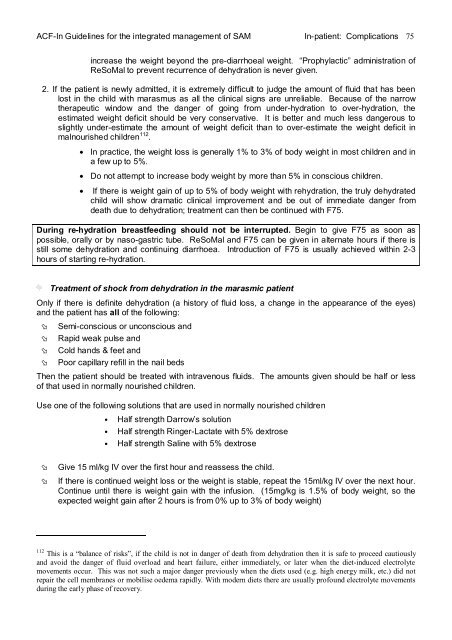guidelines for the integrated management of severe acute malnutrition
guidelines for the integrated management of severe acute malnutrition
guidelines for the integrated management of severe acute malnutrition
Create successful ePaper yourself
Turn your PDF publications into a flip-book with our unique Google optimized e-Paper software.
ACF-In Guidelines <strong>for</strong> <strong>the</strong> <strong>integrated</strong> <strong>management</strong> <strong>of</strong> SAM In-patient: Complications 75<br />
increase <strong>the</strong> weight beyond <strong>the</strong> pre-diarrhoeal weight. “Prophylactic” administration <strong>of</strong><br />
ReSoMal to prevent recurrence <strong>of</strong> dehydration is never given.<br />
2. If <strong>the</strong> patient is newly admitted, it is extremely difficult to judge <strong>the</strong> amount <strong>of</strong> fluid that has been<br />
lost in <strong>the</strong> child with marasmus as all <strong>the</strong> clinical signs are unreliable. Because <strong>of</strong> <strong>the</strong> narrow<br />
<strong>the</strong>rapeutic window and <strong>the</strong> danger <strong>of</strong> going from under-hydration to over-hydration, <strong>the</strong><br />
estimated weight deficit should be very conservative. It is better and much less dangerous to<br />
slightly under-estimate <strong>the</strong> amount <strong>of</strong> weight deficit than to over-estimate <strong>the</strong> weight deficit in<br />
malnourished children 112 .<br />
• In practice, <strong>the</strong> weight loss is generally 1% to 3% <strong>of</strong> body weight in most children and in<br />
a few up to 5%.<br />
• Do not attempt to increase body weight by more than 5% in conscious children.<br />
• If <strong>the</strong>re is weight gain <strong>of</strong> up to 5% <strong>of</strong> body weight with rehydration, <strong>the</strong> truly dehydrated<br />
child will show dramatic clinical improvement and be out <strong>of</strong> immediate danger from<br />
death due to dehydration; treatment can <strong>the</strong>n be continued with F75.<br />
During re-hydration breastfeeding should not be interrupted. Begin to give F75 as soon as<br />
possible, orally or by naso-gastric tube. ReSoMal and F75 can be given in alternate hours if <strong>the</strong>re is<br />
still some dehydration and continuing diarrhoea. Introduction <strong>of</strong> F75 is usually achieved within 2-3<br />
hours <strong>of</strong> starting re-hydration.<br />
Treatment <strong>of</strong> shock from dehydration in <strong>the</strong> marasmic patient<br />
Only if <strong>the</strong>re is definite dehydration (a history <strong>of</strong> fluid loss, a change in <strong>the</strong> appearance <strong>of</strong> <strong>the</strong> eyes)<br />
and <strong>the</strong> patient has all <strong>of</strong> <strong>the</strong> following:<br />
� Semi-conscious or unconscious and<br />
� Rapid weak pulse and<br />
� Cold hands & feet and<br />
� Poor capillary refill in <strong>the</strong> nail beds<br />
Then <strong>the</strong> patient should be treated with intravenous fluids. The amounts given should be half or less<br />
<strong>of</strong> that used in normally nourished children.<br />
Use one <strong>of</strong> <strong>the</strong> following solutions that are used in normally nourished children<br />
• Half strength Darrow’s solution<br />
• Half strength Ringer-Lactate with 5% dextrose<br />
• Half strength Saline with 5% dextrose<br />
� Give 15 ml/kg IV over <strong>the</strong> first hour and reassess <strong>the</strong> child.<br />
� If <strong>the</strong>re is continued weight loss or <strong>the</strong> weight is stable, repeat <strong>the</strong> 15ml/kg IV over <strong>the</strong> next hour.<br />
Continue until <strong>the</strong>re is weight gain with <strong>the</strong> infusion. (15mg/kg is 1.5% <strong>of</strong> body weight, so <strong>the</strong><br />
expected weight gain after 2 hours is from 0% up to 3% <strong>of</strong> body weight)<br />
112 This is a “balance <strong>of</strong> risks”, if <strong>the</strong> child is not in danger <strong>of</strong> death from dehydration <strong>the</strong>n it is safe to proceed cautiously<br />
and avoid <strong>the</strong> danger <strong>of</strong> fluid overload and heart failure, ei<strong>the</strong>r immediately, or later when <strong>the</strong> diet-induced electrolyte<br />
movements occur. This was not such a major danger previously when <strong>the</strong> diets used (e.g. high energy milk, etc.) did not<br />
repair <strong>the</strong> cell membranes or mobilise oedema rapidly. With modern diets <strong>the</strong>re are usually pr<strong>of</strong>ound electrolyte movements<br />
during <strong>the</strong> early phase <strong>of</strong> recovery.

















